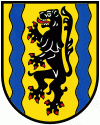Nordsachsen (Landkreis Nordsachsen)
 |
The district was established by merging the former districts of Delitzsch and Torgau-Oschatz as part of the district reform of August 2008.
On 10 December 2009 the district council adopted the district's new coat of arms.
* “Or a lion rampant Sable armed and langued Gules between two pallets wavy Azure.”
Map - Nordsachsen (Landkreis Nordsachsen)
Map
Country - Germany
 |
 |
| Flag of Germany | |
Various Germanic tribes have inhabited the northern parts of modern Germany since classical antiquity. A region named Germania was documented before AD 100. In 962, the Kingdom of Germany formed the bulk of the Holy Roman Empire. During the 16th century, northern German regions became the centre of the Protestant Reformation. Following the Napoleonic Wars and the dissolution of the Holy Roman Empire in 1806, the German Confederation was formed in 1815.
Currency / Language
| ISO | Currency | Symbol | Significant figures |
|---|---|---|---|
| EUR | Euro | € | 2 |
| ISO | Language |
|---|---|
| DE | German language |























